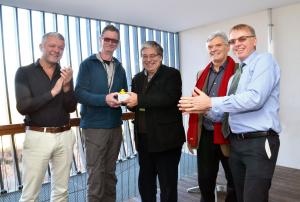ITER vacuum system moves forward
There was no slowing down for the Vacuum team at the end of last year as two major design reviews for the ITER vacuum system were held over an intense four days.
The first was for the vacuum vessel and auxiliaries leak detection and leak localization system. Liam Worth, responsible for the leak detection and localization system for ITER explains: "Modern tokamaks can be brought down by a mere pinhole in their vacuum system or piping networks. Whether microscopic or visible, holes, cracks and faults cause leaks, which in turn allow air, water or helium to diffuse into areas that are forbidden to them. At best, a leak can seriously degrade the machine's performance; at worst, it can stop operations." The review came after an intense R&D program. "Passing the review," says Liam, "successfully puts ITER's main vacuums in a strong position to support reliable operations."
The second review was for the cryopump cryogenic supply system, which effectively controls the heating and cooling of ITER's 18 cryo-pumps. The largest cryo-pumping systems in the world require the largest cryo-pump cryogen distribution system. At the core of the system are the 12 cold valve boxes that distribute cryogen and gas supplies to each pump.
Review chair Wolfgang Obert, the Cryogenic Group Leader at JET and the person responsible for the cutting-edge design and operation of JET cryogenics system, commented: "The meeting was well prepared by the ITER Organization and a considerable amount of work had gone into the design. The system can now go forward to Procurement Arrangement, final design and manufacturing milestones."
"The two reviews involved around 100 presentations, even more drawings and documents, and many man years of design preparations," concluded Robert Pearce, ITER Vacuum Section leader. "The panels of experts at each review helped the vacuum team to make absolutely sure that everything is going in the right direction. The positive outcome of both of these reviews is a credit to the ITER Organization and the European Domestic Agency vacuum teams and another large and successful step towards ITER construction."



